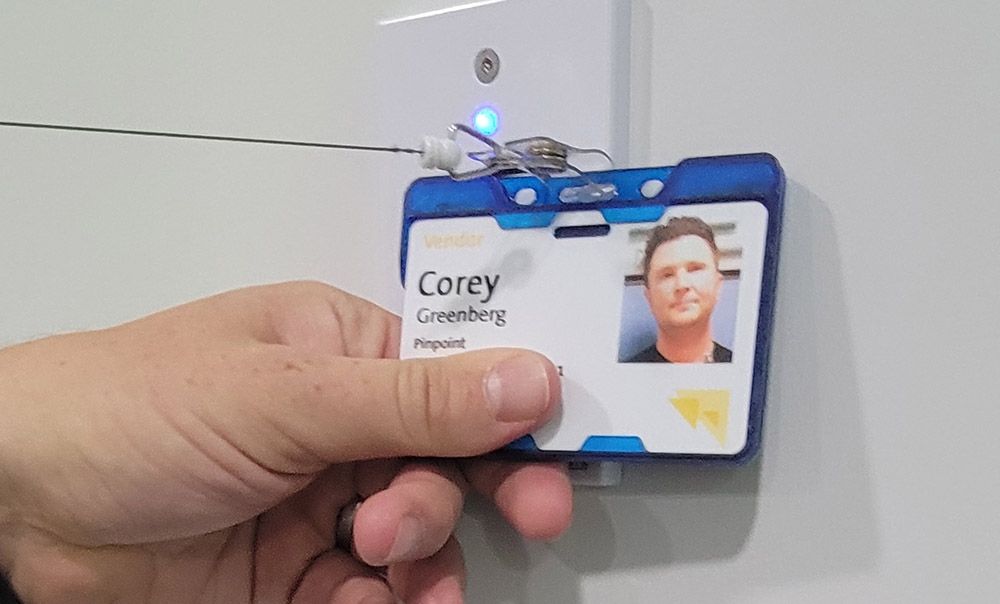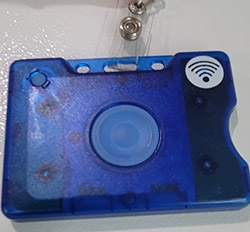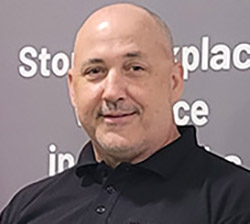Pinpoint provides solutions to prevent workplace violence in healthcare facilities Alarm company’s Panic Alarm, Patient Safety Check, Patient Nurse Call systems alleviate hospital staff concerns

By Cory Harris, Editor
Updated 10:52 AM CDT, Mon October 11, 2021

HAUPPAUGE, N.Y.—Ensuring the safety of doctors and nurses in healthcare facilities while taking care of patients offers much-needed peace of mind while ensuring their patients’ own well-being.
Even more so now, as we enter year two of the COVID-19 pandemic, the pressure that hospital workers are under is immense. Having the security of knowing that they could seek immediate help with the simple press of a button when under duress is a potentially lifesaving benefit, and a vital stress reliever.
Pinpoint, Inc. is an alarm company that offers a variety of technology solutions for healthcare workers when the need arises to issue emergency communications when an incident occurs within the confines of a medical facility that requires immediate attention.
Based out of Leven, Scotland, Pinpoint also has offices in England, Ireland, and the United States.
Security Systems News had a chance to visit Pinpoint’s U.S. location in Hauppauge, N.Y., where we witnessed firsthand how its portfolio of technology solutions is designed to prevent workplace violence in healthcare facilities.
Panic Alarm
 Corey Greenberg, Director of Healthcare Safety for Pinpoint, told us that Pinpoint noticed a need to develop solutions to address critical situations that arise in healthcare settings, with one of those solutions being one of its core products, the Panic Alarm.
Corey Greenberg, Director of Healthcare Safety for Pinpoint, told us that Pinpoint noticed a need to develop solutions to address critical situations that arise in healthcare settings, with one of those solutions being one of its core products, the Panic Alarm.
“We manufacture the only instant, personal panic alarm for healthcare, and we’ve been doing that since 1992,” he explained. “We know that in healthcare, such as emergency departments or behavioral health, there are going to be situations that arise out of nowhere, where a staff doctor or nurse might need to react because something is happening, a vital issue, a 10 out of 10 out of nowhere, so they have to react.
The Panic Alarm itself is an ID Badge Holder Personal Infrared Transmitter that features two programmable buttons. The smaller one is typically configured to request assistance, the large one for an emergency, and it communicates using infrared technology.
“That’s what this transmitter will do,” Greenberg said. “They’ll push this large button, which is an emergency call level, and they’ll be able to instantly communicate, and instantly pinpoint the exact location, because we follow the Life Safety requirements - hardwired, hardwired, hardwired. We’re not relying on a poor Wi-Fi, Bluetooth or RFI signal, which will bleed through floors, walls, and ceilings. Our hardware is hardwired because our transmitter is using infrared light. Because of the infrared light staying contained – another level of Life Safety requirements – it’s instantly pinpointing the exact location to attend.
“The other great part about our badge is that we have two buttons. The small button is an assistance, or lower call level. This is now where we can train our clients to become experts at preventing and decreasing workplace violence, and not react. If you see somebody’s at a 1 or a 2 or a 3 out of 10, they’re emotional, they’re excited, they’re verbal, you call for help right away, rather than waiting for a fire. You see smoke or you see smoke about to start, you call for help right away. This is a lower call level.”
 Greenberg called Panic Alarm “our No. 1 solution” for hospitals and other healthcare facilities looking to ensure the safety and security of their staff, noting its reliability, discreetness and ease of use.
Greenberg called Panic Alarm “our No. 1 solution” for hospitals and other healthcare facilities looking to ensure the safety and security of their staff, noting its reliability, discreetness and ease of use.
“We have clients who have used it for a patient down,” he noted. “We have a client in Delaware who was sitting at his own desk, had a stroke, and used that transmitter to call for help for himself. We can get very creative how we use this. It’s very discreet, you’re not trying to go to a wall to push a button, and you’re not relying on software updates or a signal.
“All the solutions are right here on the access control ID card. It doesn’t interfere with communication, and all your solutions are back here on the ID badge. From the time I push that button, the signal is only going to one location. I push the button, and the signal is only going to that receiver. We have an internal receiver and an external receiver. Our external receivers are enclosed in weatherproof cases, so if you need one for an outside guest visitor entrance, an ambulance bay, courtyards, patios, we have that.
“Our common internal transmitter follows Life Safety requirements, is hardwired and anti-ligature, which is very important in behavioral health. We have tamper mechanisms built in, so if there was a water leak or the power went down, we’re alerting you right away.”
Receiving Alerts
Greenberg pointed out that there are five different locations – three with no network connection, two with a required network connection - where Pinpoint’s Panic Alarm can be received to alert someone of a potential incident.
“After that receiver gets the alert, it’s where is it feeding the alert. The first location it’s going to is our hardwire display,” he said. “No network connection is needed yet. If somebody wants to install a standalone system, which is very similar to a fire alarm system that is built to last a lifetime, it’s the same exact concept, so the first place you’re going to get an alert is the display.
“This is where the client can design it to say whatever you want it to say, in as much detail that makes sense. It can say ‘Tower A, fourth floor, patient room 404,’ and the call level – emergency or assistance. That’s the first location.
The second and third locations where Panic Alarm alerts are received are the over door light and audible sounder.
“The over door light can go up to many colors, so now we’re starting to customize an install,” Greenberg explained. “For example, if I push the small button – assistance – maybe the light goes green and the sounder stutters. If I push the large button – emergency – the light goes red and the sounder is constant. This is where we start to customize your install for muscle mental memory. If you’re coming at me, I don’t need to say, ‘Oh, stop!’ I know how to push the button. If I hear and see something, I know what that means and where to go. Those are the three ways we can alert you without a network connection.”
Network connections are needed for the other two locations where Panic Alarm alerts are sent – Pinpoint’s PC Alert and Mobile Alert.
PC Alert is an application that brings alerts to a desktop computer. Each installation can be configured to display one or all alert types from any addresses that suit the user’s needs, which allows the user to only be informed of events happening that are relevant to them.
“This PC Alert can go on any computer in the building, out of the building, across the state, but it’s going to alert someone using the same exact information on the call level,” Greenberg noted. “You could have green for assistance with the sounder, or the call might have been escalated and is now listed as an emergency call level, and that’s why it’s red. It’s telling you the same location – where to go, where to attend.”
 Pinpoint’s Mobile Alert features all the important information ranging from alarm messages and patient calls to information on the health of your system, and this information could be sent to mobile Android and iOS devices. Mobile Alert sends all this data through the cloud to devices running Android 4.4 or above.
Pinpoint’s Mobile Alert features all the important information ranging from alarm messages and patient calls to information on the health of your system, and this information could be sent to mobile Android and iOS devices. Mobile Alert sends all this data through the cloud to devices running Android 4.4 or above.
When an alarm is activated on the Pinpoint system, it is instantly forwarded to the devices subscribed to that zone. When the handset receives the alarm, the phone will be woken up and a full screen notification appears, indicating the level of call (in text as well as by color), the system it originated from, the zone, and the original address, along with a vibration that the user could then tap to acknowledge the call.
“It’s pretty cool that we have five ways of alerting you from this receiver - the display, the overdoor light, the sounder, PC Alert and the mobile app,” Greenberg said. “That’s our first solution, which is Panic Alarm, protecting your workers in healthcare.”
15-Minute Bed Check
The second solution that Pinpoint developed for healthcare facilities is the 15-minute Patient Safety Check system.
“A behavioral health patient is supposed to be checked in on every 15 minutes to make sure he or she hasn’t harmed themselves or a roommate,” Greenberg said.
Since patient checks need to be documented with the healthcare worker’s name, date, time, and location, Pinpoint’s system allows staff members to just tap their ID badge on a sensor located in each patient’s location, and the system will record the employee’s ID, date, time, and location of each visit in a secure digital log.
“What we do is put this somewhere in the room so you can’t just tuck your head in or use a pen and a paper,” Greenberg noted. “You come in the room and tap your badge ‘One Mississippi.’ A light will let you know that it received the communication and you checked in on the patient. If I had two patients, I would have two panels – each panel represents each patient. It’s a very important solution.”
Patient Nurse Call
Pinpoint’s third solution is Patient Nurse Call, which is designed to improve communication between patients and nurses.
Patients can utilize either fixed or mobile call buttons to request help from anywhere in the healthcare facility. Staff members may configure their alerts to be visual, audible, or displayed on a computer or mobile device.
“Again, it’s hardwired, anti-ligature, Life Safety requirements,” said Greenberg on the Patient Nurse Call system. “We’re forcing you to check in on the patient and letting everyone know that you’ve responded, and the patient is okay.”
Growth in 2022
Currently, Pinpoint provides its healthcare workplace violence solutions in more than 350 healthcare systems, with more than 3,000 installations and over one million badge transmitters.
Looking ahead to 2022, Greenberg stressed the importance of Pinpoint growing exponentially and continuing to make its mark in the critical area of healthcare worker safety.
“The biggest thing that we really want to achieve this coming year is growing our reseller channel, our security integrators and our partners,” he said.
The Right Solution
With the safety solutions that Pinpoint offers the healthcare community to reduce the occurrence of violent attacks, doctors, nurses and other staff members feel more secure knowing that mechanisms are in place throughout the building to protect them.
 “When people realize they have a problem, we have the solution, but they don’t know what the solutions are,” said Joe Saggio, Partner/Founder, Flexible Business Systems, the parent company of Pinpoint. “They start researching, and there’s a lot of solutions that don’t work. Then they come to us and they finally find a solution they can count on. It’s exciting because nobody has the same thing.”
“When people realize they have a problem, we have the solution, but they don’t know what the solutions are,” said Joe Saggio, Partner/Founder, Flexible Business Systems, the parent company of Pinpoint. “They start researching, and there’s a lot of solutions that don’t work. Then they come to us and they finally find a solution they can count on. It’s exciting because nobody has the same thing.”
Knowing that Pinpoint’s products have had a positive impact on the lives of healthcare workers around the world is what really drives Tim Honohan, Director, Install/IoT Team, Pinpoint.
 “I think from a technical standpoint, and a serviceability standpoint, that’s what struck me most about the system – its design and its simplicity,” he noted. “One of my first experiences was at Forest Hills Hospital, and we had an alarm go off. We weren’t able to see what was going on, but we saw security run by us, and within 30 seconds to a minute, they had the situation under control because they knew exactly where the commotion started. We heard the yelling and screaming, and that person was quickly taken off the floor and into the emergency room.
“I think from a technical standpoint, and a serviceability standpoint, that’s what struck me most about the system – its design and its simplicity,” he noted. “One of my first experiences was at Forest Hills Hospital, and we had an alarm go off. We weren’t able to see what was going on, but we saw security run by us, and within 30 seconds to a minute, they had the situation under control because they knew exactly where the commotion started. We heard the yelling and screaming, and that person was quickly taken off the floor and into the emergency room.
“I guess what struck me was how quickly that all transpired. The reliance on the system from the nurses and their staff really struck me. They count on that system and use it on a daily basis, not only for emergency instances, but also for assistance.”
Honohan added that he believes that Pinpoint’s solution to prevent workplace violence is the ideal choice for hospitals and other medical facilities, based on his own experiences and what he has heard from the workers themselves.
“I think for me, personally, when I get questioned about the system, I have the belief that this is the correct solution,” he pointed out. “I don’t sell it, it’s more based upon my experiences with it and experiences of the hospital staff directly. It’s really encouraging to see the progression of Pinpoint here in the States. It was a system that was exclusively used in the UK, but we do see the adoption here in the States. There is a need for it, unfortunately.
“For me personally, if I had a wife or daughter who were staff members at a hospital, I would feel more comfortable knowing that they had the ability to instantaneously call for help discreetly. That’s a difference maker for me.”
Comments